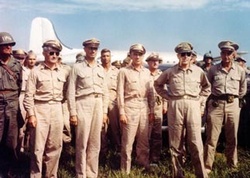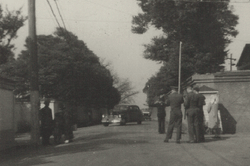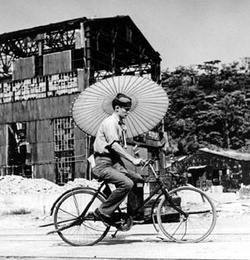The war is over and parts of the country, including parts of the capitol, are in ruins. US military forces move in as occupiers, serving as a transition until the country can be rebuilt and a new government installed.

General Douglas MacArthur (second from right) arrives at Atsugi Air Base outside of Tokyo on August 30, 1945, ready to take over the country as Supreme Commander, Allied Forces, an unprecedented position of power. (Photo courtesy of the Dept. of Navy)
Actually, a new government wasn’t installed, at least, not completely. This isn’t Iraq in 2003. It’s Japan in 1945, weeks after the atomic bomb was dropped on Hiroshima and Nagasaki, which led to the surrender of Japan and the end of World War II.
A half-century later, Americans have celebrated so much about World War II—the righteousness of the war, the heroism of the “greatest generation,” the memoirs and monuments that commemorate those who lost their lives. But there’s very little awareness in the US of what life was like in postwar Japan, when American forces arrived and a unique moment in history occurred: A foreign general ran a nation in a peaceful takeover and then gave the country back to her people after seven years.
I was born in Tokyo after the occupation of Japan officially ended, but I grew up with the signs of the American presence all around me.
My life was split between the American kids and schooling I got on military bases and my Japanese friends and the daily routine of early-‘60s urban Japan. American uniforms were still a commonplace sight all over Japan, although in most cases off-base they were worn by soldiers, sailors and aviators who were tourists on leave from duty. Most of the grownups I met through my dad were tall Caucasian men with severe crewcuts and equally tall (to me, anyway) Caucasian women all prettied up to look as much like Jackie Kennedy as possible.

Gen. MacArthur on his clockwork-like daily drive from his residence to to his office at the Dai Ichi building across from the Imperial Palace. (Photo courtesy of Med and Mariagnes Medrud)
And although the first McDonald’s, Kentucky Fried Chicken and Dunkin’ Donuts had yet to pop up in Japan, the first modern waves of American consumerism had begun to invade the country. Big American cars were a status symbol, especially compared to the tiny “Toyopets,” a popular Toyota compact car that crowded the streets. And by the mid-‘60s shows such as “Batman” were a staple on Japanese television alongside homegrown adventure series like “Ultraman.” Even American-style wrestling, pre-WWF but already as much showbiz as athletic contest, was beginning to rival sumo with fans.
What I know of the Occupation, which lasted from Emperor Hirohito’s surrender in 1945 to the 1952 signing of a Peace Treaty that returned Japan to independence, is what I’ve learned on my own from readings books including the excellent Pulitzer Prize-winning history “Embracing Defeat” by John Dower. There isn’t much else out there in other books or movies that tell about the era.
Japan was devastated by the war, with most of its major cities including much of Tokyo bombed into rubble. When the US soldiers showed up, starvation and disease were rampant. So was homelessness—especially of orphans and Japanese soldiers returning from the war in Southeast Asia and the Pacific. Thousands of people including children died in the weeks after the war in train stations and parks simply from lack of food and shelter. (For a gripping though painfully sad and very realistic telling of this experience, find a copy of “Hotaru No Haka” (“Grave of the Fireflies,” an animated film about two orphaned children at the end of the war.)
Led by the autocratic General Douglas MacArthur, who never ventured out into Japan during his Occupation and stayed either at his office in a downtown Tokyo office reclaimed by the military or at his official residence, the US forces instituted wholesale changes on Japanese society on a level unheard-of in modern times.
The government was changed with a new democratic Constitution modeled on Western values (and made even more liberal than the US constitution with stated equal rights for women, thanks to a Nisei woman who worked on the document); the economic system was reorganized and the pre-war system of “zaibatsu,” dominant large companies that controlled most of the country’s industry, broken up; land reform split up large farms and gave property to small farmers for the first time; organized labor was encouraged (at first, anyway); and even the educational system was rebuilt in the style of American schools, with strict control over content and restrictions over anything that could be taken as fostering militarism.
Most important, MacArthur allowed Japan’s emperor to escape prosecution as a war criminal and remain in power, at least as a figurehead, giving a sense of continuity that historians credit as one of the main reasons the US Occupation was so effective. Another was the use of thousands of Japanese-speaking Nisei as translator, interrogators, aides and liaisons, both military and civilian employees (including some who had been stuck in Japan from before the war) to smooth the way and serve as a ridge between the victors and the vanquished.

A US sailor holding a parasol and horsing around on a Japanese bicycle, one type of cross-cultural scene from the Occupation. (Photo courtesy of Dept. of the Navy)
It was a time of such economic and social flux that returning Japanese soldiers pounded out their helmets and sold them as frying pans on the streets, and cartons of American cigarettes were used as currency for transactions instead of yen, dollars or military scrip. The black market thrived, which meant corruption was rampant. However, history hasn’t recorded some of the things that surely must have gone wrong during the US Occupation of Japan—at least the history I’ve come across so far.
There were no attacks on US military even in the first days of the Occupation, despite the many fears that loyal Japanese soldiers might make a desperate attempt to fight to their death.
There was no looting or sacking of any property in Japan by the Japanese. Most of the country’s cultural treasures—much of which were in Kyoto, the one major city spared from the relentless firebombing out of respect for Japanese heritage—remained intact.
I figured the lessons we must have learned in the past would be applied to the occupation of Iraq in the weeks after President Bush declared victory. Granted, the situation in the Middle East is vastly different from what happened in Japan or even in Germany after WWII. But surely the US must have had a plan to restore peace, establish a workable government and rebuild Iraq, I thought.
But months after the official end of fighting things still seem chaotic over there and US troops are still being killed. It makes me wonder how much the administration thought about their post-war plan, and like many people, the seeming scattershot handling of both the war and the peace makes me question the righteousness of the reasons for fighting.
The Occupation of Japan may have lasted only seven years, but decades later, Americans are still very much occupying the hearts and minds of the Japanese, in what I think is mostly a good way. I wonder how the Iraqis will feel about the US presence in their country 50 years from now.
*This article was originally published in NIKKEI VIEW: The Asian American Blog on June 9, 2003.
© 2003 Gil Asakawa






